One of the most common questions I get is “what does your day look like?”
And after that, “What curriculum do you use?”
This post should answer those questions. At least for this month – I have a feeling that our typical day will continuously change.
So, as of right now, this is how it all goes down.
(All times are estimates, especially my time of awakening.)
7:30: I wake up, have my bible study time, and take a shower. Ali also wakes up, takes care of her personal grooming, and plays in her room until I’m ready. Noah is a blessedly odd bird who never tells me when he wakes up, and plays quietly in his crib until I get around to fetching him.
(As a note, none of us see Chris in the morning. He leaves quietly around 7:15, before any of us rouse.)
(Don’t hate me already if you have sadistically early risers. I’m sorry. I truly am.)
8:30: Breakfast. Nothing special – cereal for Ali and I, and Nutri-grain bars and dry cereal for Noah. If kids can be stunted or permanently traumatized for never being fed hot breakfasts, mine will be the first in line.
9:00: We start school.
We always start with math – I figure Ali’s brain is fresh and fueled with highly nutritious Apple Jacks or Lucky Charms, so I better put it to good use. I talked some about our math last week, but to clarify, I am currently doing about 60% Mommy-Provided and 40% Curriculum-Provided Education.
Mommy-Provided currently includes addition and subtraction problems, multiplication tables, and division.
Any time we can make this more fun, we do. For instance, last week, Ali had a Math Fairy helping her:
She’s great for doing the heavy lifting that tends to wear out a five year old.
For curriculum, we’re using Miquon Math (the Red Book), along with Cuisenaire Rods. This is a great visual math curriculum, using pictures, rods, coloring, dot-to-dots, and standard math problems to learn. I also like it because you’re encouraged to skip around (because it’s visual and easy to understand and the lessons don’t build on each other), and it teaches many different aspects of math in each book, rather than harping exhaustingly on one skill.
It’s drawback: very little teacher help in explaining concepts.
Ali’s favorite pages have been the fraction pages, because it encourages you to draw and color to produce the answers.
(And yes, that was the photo with the little brother interruption.)
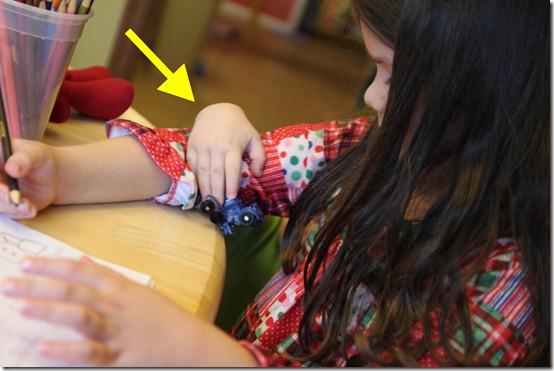
(For more information on what Noah does during school, you can check out his guest post here.)
Math usually takes between 30 minutes to an hour, depending on how quick Ali’s brain is working from her artisanal breakfast. And because that’s her favorite subject, we spend longer on it than anything else.
9:45: Bible and Handwriting.
For bible, we’ve been using a book called My ABC Bible Verses. It has a memory verse, then a little story to explain the verse. I read the verse and story on Monday, and then Monday through Friday, we use the verse as part of our handwriting practice.
We talk about the verse a little more each day, and she typically has it memorized within a couple of days.
However, I had issues with handwriting early on, as it was the first item of schoolwork that made her cry.
(Which, by the way, when you’re homeschooling and school makes your kid cry, your Mommy Guilt goes THROUGH THE ROOF.)
I had impressed upon her that the reason for handwriting was to learn how to write letters really well, and during an especially stressful school day when I was dealing with Noah and a dozen other things (and had probably already been short with her), she wrote what she felt was a “bad C”, and burst into tears before I even saw it.
I pondered this, and realized I needed to take a different approach: positive, rather than negative reinforcement.
(Duh.)
So starting last week, I told her that I was going to make a dot on all of her perfect letters each day, and TWO dots on the letters that were better than mine, and when she got 100 points, she would get a special surprise out of my reward drawer (which houses random crap trinkets that she adores.)
Sure enough, this motivation worked wonders in her handwriting excitement, and she had gotten over 100 points by the end of the week.
During handwriting, which takes about 20 minutes because she’s so bent on getting her points, I take the opportunity to spend time with Noah. We read books and play, and this helps him stretch to make it through our (oh-so-long) two hour school day.
10:00: We take an Art break. We either do drawing, a craft, or some other such project. I have a few books from Usborne that I LOVE for this time, including 365 Things to Draw and Paint and Lots of Things to Find and Color
, the latter of which has the added benefit of working on reading instructions and comprehension.
10:20: We move from the dining room table to the couch.
(Please note: We DO NOT have a fancy schoolroom that you can pin on Pinterest. It’d be nice, but really, with a toddler running around, it’s easier to be in the middle of the house to minimize melee.)
To the couch. We take a book for Ali to read to me, a Sciencey book for me to read to her, our history book, and a read-aloud book.
For her reading, we’re borrowing early reader books from the library. Her favorite series include Fancy Nancy, Pinkalicious
, Fly Guy
, Dr. Seuss
, and my personal favorites, Jane O’Connor’s Non-Fancy-Nancy books like Snail City
and Splat.
The first week of school, it took the whole week for her to read me one or two of these books, and she hated it.
Although her reading improved every week, she still despised it for several weeks. But somewhere during the fifth week of school, she proclaimed, “I like reading now!!” – it was a beautiful moment indeed.
She is now up to reading one book a day in about 20 minutes (except for Seuss – his books are painfully long, so we spread them over multiple days.)
For history, we’re using A Living History of Our World: America’s Story, which is a conversationally written chronological book. It’s meant to be supplemented with ancillary reading from biographies and such, but since Ali is so young, we’re just reading through it.
I like it because it’s written from a Christian perspective, but presents all sides of the story and offers discussions about many different views of an event depending on the perspective of the person witnessing it.
I bought the journal to go with it, but quickly realized that it was overkill and way too much work for Kindergarten.
So we ditched it.
For read-aloud time, I’m working through my list of 215 Read-Aloud books (we’re currently in the abridged version of Pollyanna), as well as supplementing with fun learning books, like Usborne’s Princess Treasury
, which thrills Ali as it teaches about how historical and modern-day princesses live.
For science, I’ll pick up a stack of learning books from the library on whatever subject Ali is interested in that week (Sunflowers, trees, bugs, the body – her favorite book by far has been Reader’s Digest’s Looking Into My Body), or we do an around-the-house science experiment from Science Play
.
(When it comes to Science, my philosophy so far has been to learn a little about a bunch of completely random stuff.)
11:00: We’re done for the day.
Things that I need to add to our day:
1. Spelling. I bought Spell to Write And Read because I liked their philosophy on using phonics-based spelling as a basis for writing and reading, but I can’t understand how to teach it for the life of me. I even bought an explanation DVD – which I haven’t found time to watch.
2. Hands-On and Creativity. I’ve been pretty lazy thus far, and would like to do more science experiments, nature walks, projects, and FUN stuff.
3. Organization and Neatness. My office, and house in general, have suffered with the addition of two hours of homeschooling a day. (And Noah being bored for two hours a day.)
Are you homeschooling? Want to share about your day? I would LOVE to see how other family’s days work! Link up here:
Feel free to ask any questions about our day, or about homeschooling in general, below!
The follow-up, our day in First Grade, is available here.

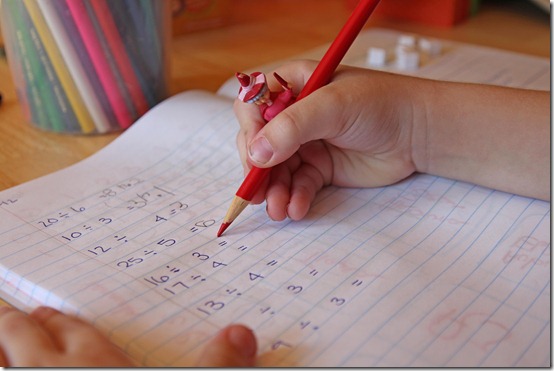
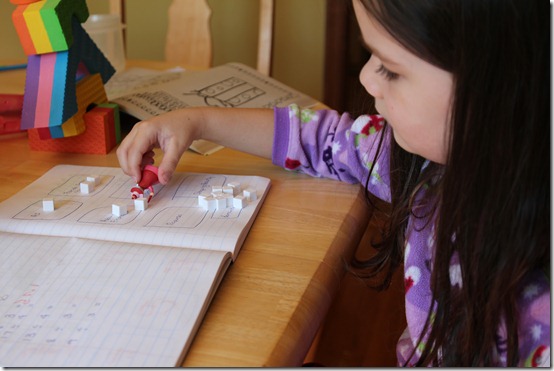
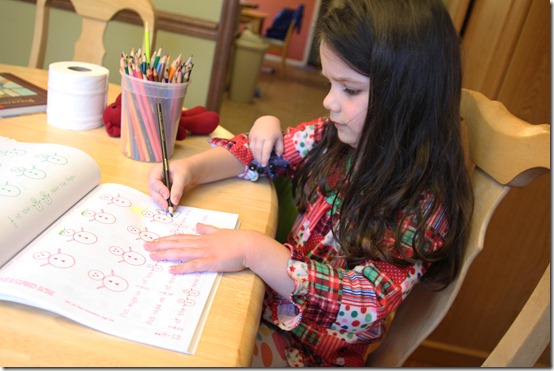
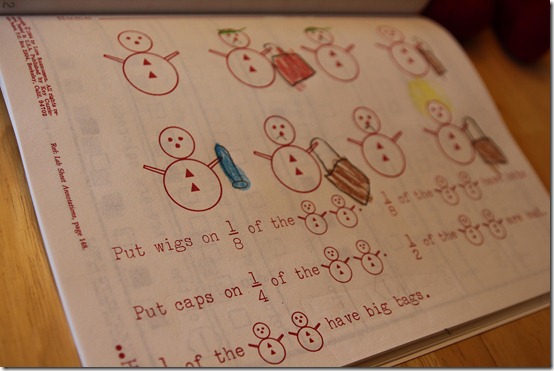
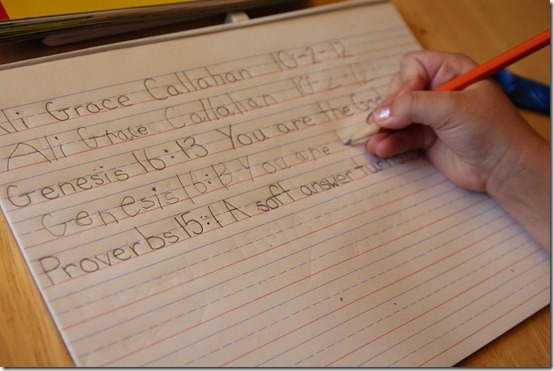
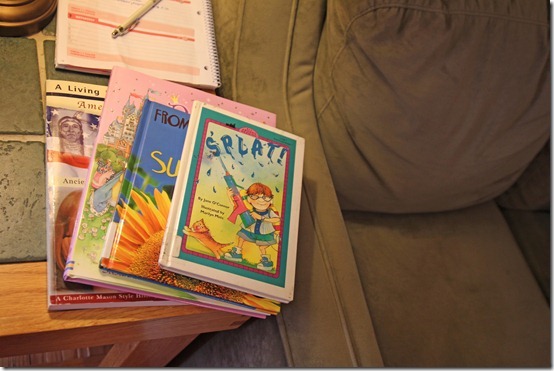
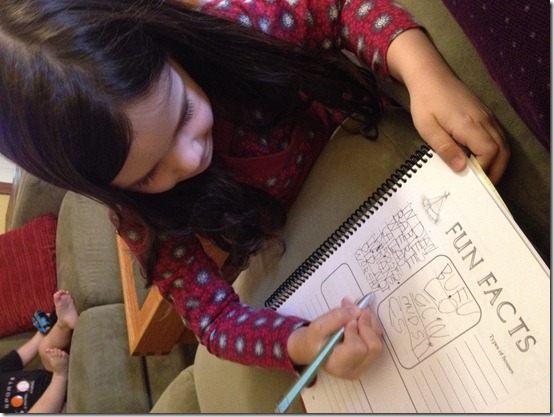

Hey Rachel :) Sounds like lots of fun! Our day is similar, except that with 3 in school (5th, 3rd, and 1st) plus one 3 year old, things take a lot longer. ;). If you’re looking for more science experiments, check out the Home Science Adventure kits from Rainbow Resource. There are 2 different kits, each cover 3 topics. One kit will last a whole year if you do science 2 days a week. They include worksheet packets, instructions, and everything you need to do the experiments. I did them with multiple grades at once, since it’s easy to make it more difficult.
Thanks!! I need to get into the Rainbow Resources more – everyone recommends them! That catalog is just so huge that it intimidates the fire out of me.
Thanks for writing this! I’m going to bookmark it for later when my kids get older. I’m already excited for the day when we officially start “school.” Question- when did you start scheduled teaching with your kids? I’m going to try to start going over a letter each week with my little boy (19 months) because he is already learning so fast. I feel like he is ready to start something. I’m already worrying about doing a good job teaching him. That’s what most moms do right?!?!
This year is the first year that we’ve actually had scheduled, structured school (and Ali is 5). We’ve done unstructured, “fun” school since she was the age of your little one, but she loved learning from an early age. Noah (22 months) has zero educational interest at this point.
Thank you for sharing all this info – I am filing it away for the future!
I’m homeschooling our oldest two boys. One is in Kindergarten, the other is doing 2nd grade work.
Our typical day looks like this:
*8 a.m. Start with Phonics/Reading, Math, (Both boys) short break, Spelling and Handwriting (for the oldest)
*Break whenever he gets done.
*1 p.m. 2 year old goes down for nap. Oldest two on T & Th is Science, W & F is Social Studies followed by Bible.
*Monday afternoons is our Home Schooler’s Academy co-op.
The two year old (daughter) does puzzles, colors and makes a general nuisance of herself until her Kindergarten brother finishes his work and plays with her. Baby brother (4 mos.) hangs out and naps while we do school.
We use McRuffy for science and love it! It is very hands on and has a workbook that accompanies it, but you don’t use it every lesson.
That’s great! I want a coop in our area – we don’t have many yet!
Our small school uses Spelling City online for spelling practice. You can either do it for free or subscribe (more game options and tracking available if you subscribe). You can enter a list of words each week and the kids can play games and take practice tests on their own. I think one teacher has the kids do assignments online as well (like putting the words in sentences) but my kids aren’t in his spelling class so I don’t personally have experience with that. My girls love it and it makes boring spelling practice a lot more fun – especially if spelling comes a little harder. I don’t think the subscription cost is terribly expensive.
I would be interested to know if anyone has math ideas – I have a 5th grader who struggles and needs extra practice. I don’t homeschool all year – but do things during the summer to keep their brains engaged.
Yes! I have the iPad app for Spelling City, and Ali loves it. We’ve been using that a lot since I can’t seem to figure out my spelling curriculum.
Thanks!
She has rather good handwriting for her age. I’m impressed.
Thanks! Are you looking at hers, or my example lines? If you’re looking at mine, then I’ll take your compliment for myself. ;)
Lol!!! Hers ; ) My 6 year old is still in the “oh so that is what those lines on the paper are for!” stage…and a few of the other kids in her class seem to still be also (she is in public K this year) Such a wide range of ability in this age group it seems!
Yes, so true!! And all are perfectly normal. It seems like everything levels out in a couple of grades.
Thanks for the insight into your day! I’m really enjoying your homeschool posts!
i loved the photo of noah grabbing ali. i noticed it right away b/c it happens a lot around here as well! samuel does do pretty good during school, but i do have to wrestle him a little when he wants to sit on my lap and grab everything in sight. for those times when he’s just plain naughty, i put him in the pack-n-play that i leave set up in the laundry room next door to where we do school :) that helps a lot.
i will admit that my mommy guilt goes up reading this post even though we already homeschool. so silly of me. you’re doing a great job.
it was good to see everything you use for curriculum. oh, and i totally took a pre-printed version of your 101 book list to the library with us on saturday! i didn’t know you changed it to 215! i will have to print again. we got How to Train Your Dragon, which only daddy can ready apparently. And then a couple Ralph Mouse books. so thanks for that!
phew, that was a lot of comment.
Don’t have Mommy Guilt! Maybe one of my next posts in my series should be all of my homeschool failures.
Rachel-I will try to link up later this week, okay?
Sure! Whenever you can!
Our day takes about 2-3 hours, but we (10, 8, & 6 yr olds) start after lunch. My brain functions better that way. :) Usually by the time my 13 yr old gets home from school, we’re done and ready for snack and afternoon chores.
My youngest still isn’t fond of handwriting or reading (why are there no easy reader superhero books!?!), but I’m going to try your dot method. Hopefully that will help him.
See, I have to get it done first because otherwise I can’t relax. I was that way when I was in school, too.
Thanks for the link-up! I’ve been meaning to post about our curriculum and just haven’t had the time. Great incentive! I’m sorry about the STWAR. I would recommend finding out if there are any other mom’s in your area who use the program. You may be able to contact the Sanseri’s and ask them if they would know. They used to travel to teach parent’s how to use the program but I’m not sure if they do anymore. Like I said in my post, this is my one complaint about the program. If I had the brain power I’d like to simplify the program myself. Maybe someday. If we lived closer I would show you what I do. :) Which reminds me, I had a weird dream and you and Ali were in it. I’ll email you about it. It was weird. Anyways, thanks again!
I need to know about this dream!!
I’ve used Spell to Write and Read for years. Phonics-based learning is totally worth it. While there is a bit of a learning curve with the curriculum, SWR isn’t difficult once you figure it out.
I certainly hope to figure it out!! Hopefully the DVD will help me. If not, I may be calling on you!
Hi Rachel,
I highly recommend “Handwriting Without Tears”! I have been using this curriculum as an occupational therapist for almost 20 years and for the past 12 have been a national presenter for the company. As the name implies, it is perfect for children who get frustrated with handwriting because it uses hands-on, multi-sensory activities to teach letter formation, line placement, etc. It is simply the best at teaching children handwriting from Pre-k through cursive. I’m doing a presentation on it for the SMI homeschool group next Tuesday night.
I am very much looking forward to your presentation next week – it was the session I was most excited about all year! I downloaded the Handwriting without tears iPad app, and although Ali liked it, I was disappointed that it only worked with uppercase letters. Lowercase letters are where she gets tripped up. At any rate, I’m definitely looking forward to learning about this curriculum!
Great post (as always)! I love seeing how other homeschoolers lay out their day, and I must add that I’m really impressed with Ali’s math skills and handwriting. I like your dot over each well-written note idea, and I think I’ll steal it and use it for my son. He’s constantly asking me why “it isn’t good enough” and my favorite go-to phrase is “sloppy writing is a sign of a sloppy mind”. (Thankfully he’s not old enough yet to pull out the ol’ Doctor rebuttal . . .)
I have been bad about commenting lately, but wanted to be sure to say how much I love these homeschooling posts. I especially love that Ali is in kindergarten, as is my CAM. And we send CAM to Catholic school for what I suspect are similar reasons to why you homeschool. (I entertained the idea of homeschooling, but my husband’s job — his whole industry — imploded and so I had to go back to work sooner than we’d intended. I am also not sure that CAM would work for me, because she’s shown no interest in practicing reading with me and by comparison many of my friends’ kids have been reading since they were 3 or 4. So for a few reasons, out-of-home school was the right thing for our family for right now.) I really appreciate what you do and how you do it, and love, love, love reading these posts. Anyway, I’m teaching high school math again but love your math lessons and am absolutely getting some of those resources for CAM. And by the way — the eating the remainders? Totally would work with my lower-level high schoolers, and they’d love it. So … thank you, again, for this series. Please keep these posts coming!
Thanks so much! I’m glad it’s been helpful to you!! :)
I grew up on Miquon math and Cuisenaire rods! =)
We’ve really enjoyed them – they’re a lot of fun!